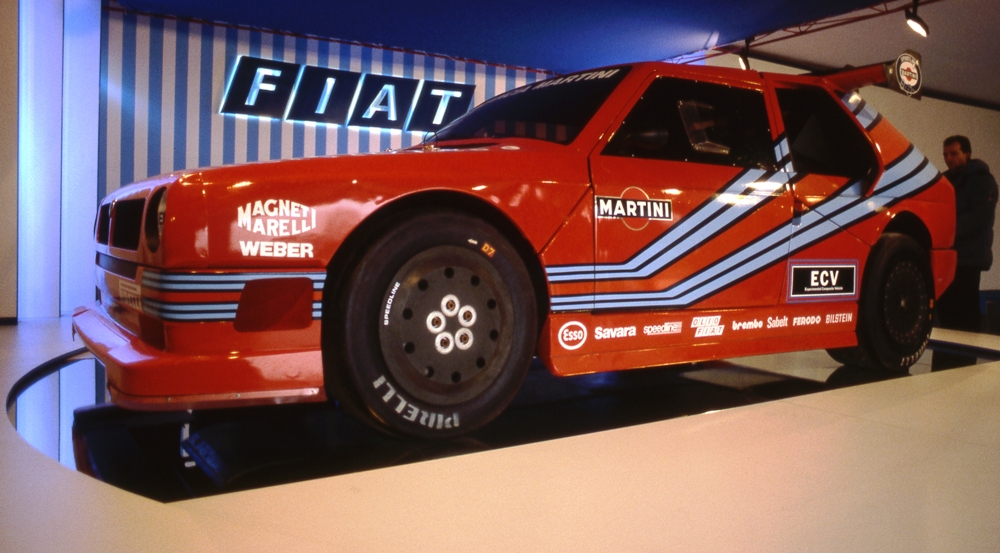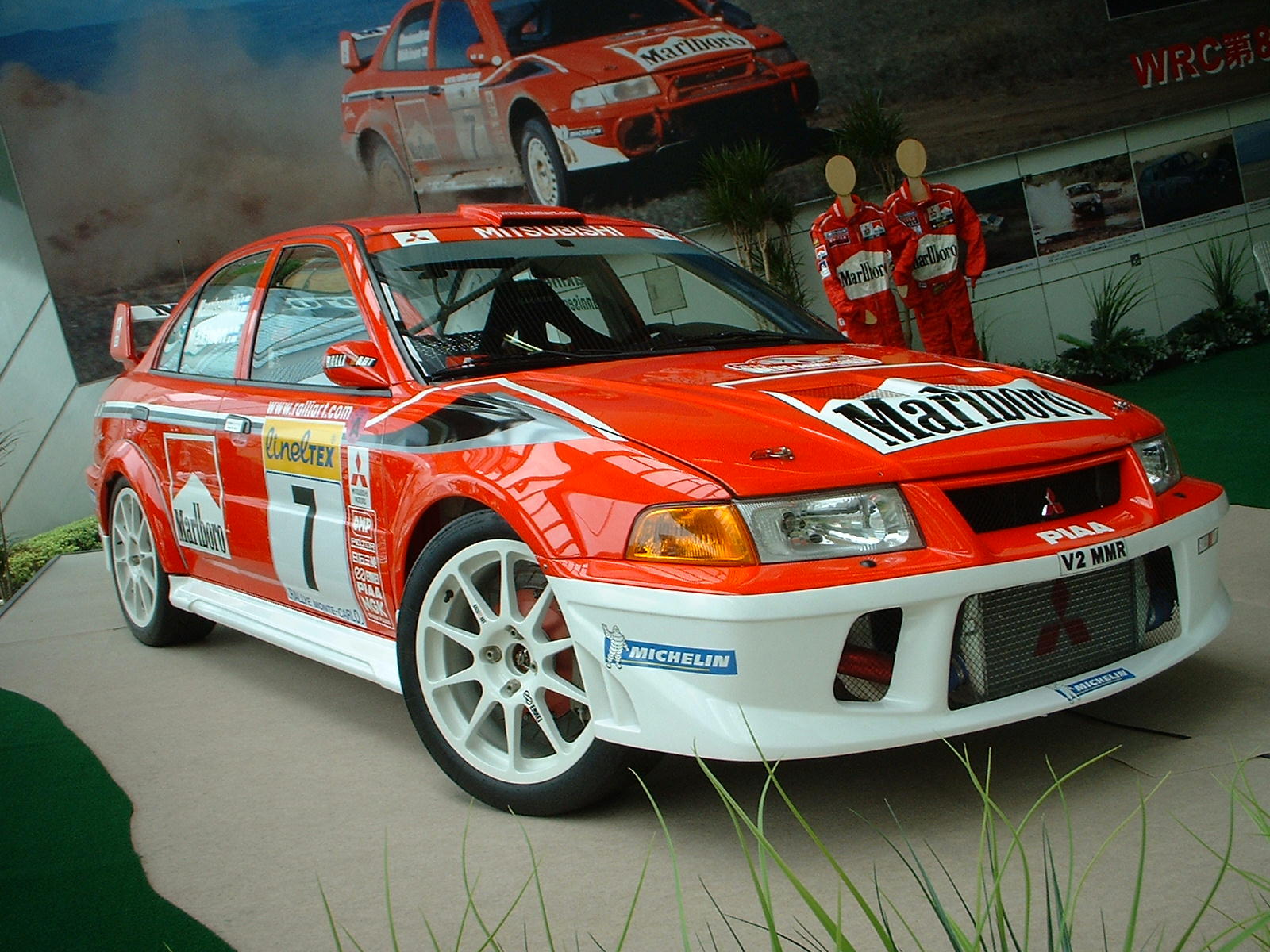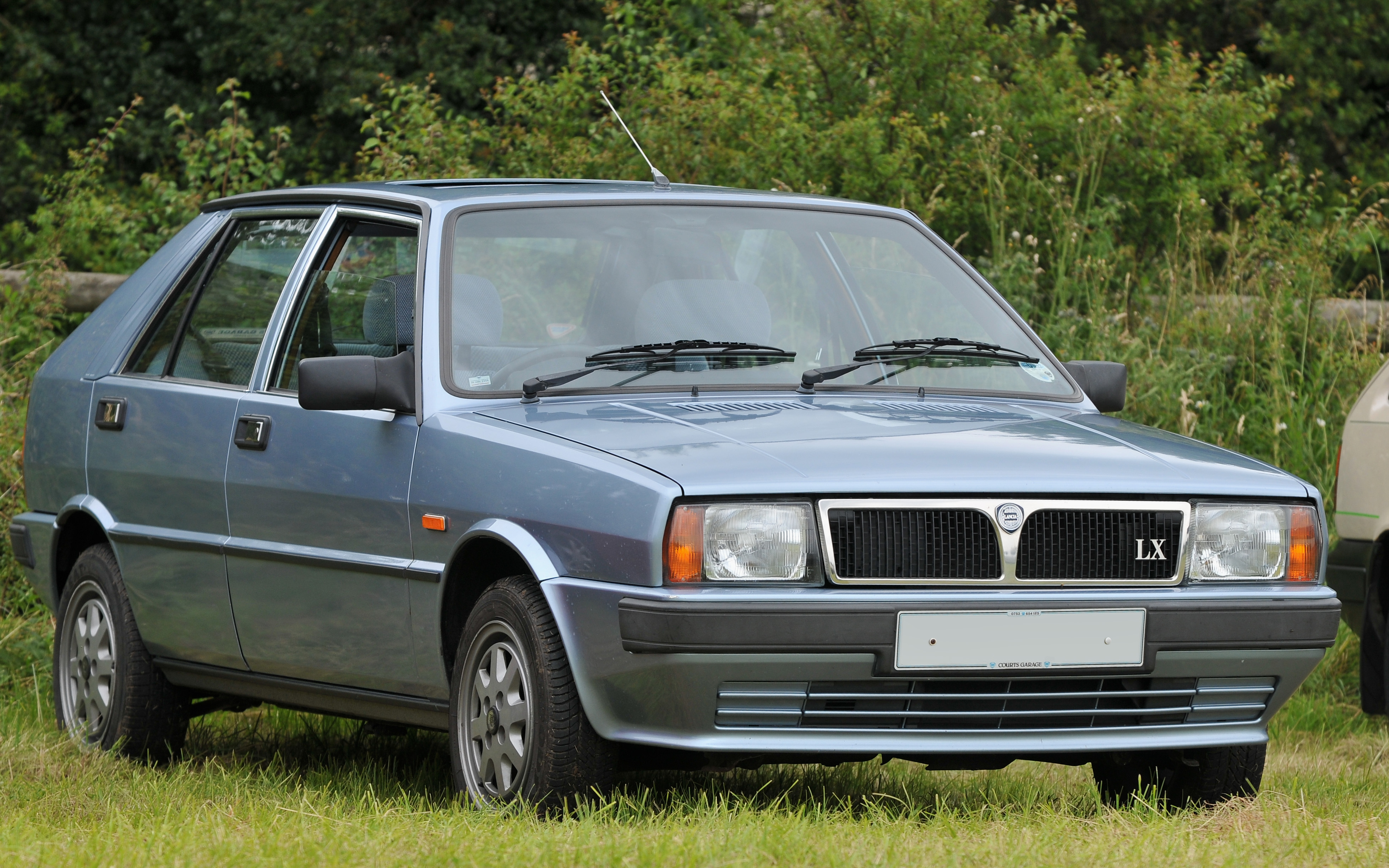|
Lancia ECV
The Lancia ECV (standing for ''Experimental Composite Vehicle'') was a prototype Group S rally car developed by the Italian manufacturer Lancia to replace the Lancia Delta S4 in World Rally Championship competition for the 1988 season. However, Group B as well as Group S cars were banned from competition by the FIA in late 1986 due to safety concerns and the ECV never raced. Lancia instead developed the Group A Lancia Delta. The car originally produced over 600 horsepower (448 kW) from a 1759 cc twin-turbocharged engine. This engine, christened TriFlux, was built in an unusual fashion; the valves were crossed (for each side of the cylinder there was an intake and an exhaust valve), so that the two turbochargers could be fed with two separate manifolds. A single manifold carried the intake air (hence the name, from the three separate air ducts). However, Group S rules would have artificially limited the car's output to 300 hp (224 kW) to limit speeds. The car made extensive use of t ... [...More Info...] [...Related Items...] OR: [Wikipedia] [Google] [Baidu] |
Lancia Delta ECV At Legendy 2014
Lancia () is an Italian car manufacturer and a subsidiary of FCA Italy S.p.A., which is currently a Stellantis division. The present legal entity of Lancia was formed in January 2007 when its corporate parent reorganised its businesses, but its history is traced back to ''Lancia & C.'', a manufacturing concern founded in 1906 in Torino by Vincenzo Lancia (1881–1937) and Claudio Fogolin. It became part of Fiat in 1969. The brand is known for its strong rallying heritage, and technical innovations such as the unibody chassis of the 1922 Lambda and the five-speed gearbox introduced in the 1948 Ardea. Despite not competing in the World Rally Championship since 1992, Lancia still holds more Manufacturers' Championships than any other brand. Sales of Lancia-branded vehicles declined from over 300,000 annual units sold in 1990 to less than 100,000 by 2010. After corporate parent Fiat acquired a stake in Chrysler in 2009, the Lancia brand portfolio was modified to include rebadge ... [...More Info...] [...Related Items...] OR: [Wikipedia] [Google] [Baidu] |
Group B
Group B was a set of regulations for grand touring (GT) vehicles used in sports car racing and rallying introduced in 1982 by the Fédération Internationale de l'Automobile (FIA). Although permitted to enter a GT class of the World Sportscar Championship alongside the more popular racing prototypes of Group C, Group B are commonly associated with the international rallying scene during 1982 to 1986 in popular culture, when they were the highest class used across rallying, including the World Rally Championship, regional and national championships. The Group B regulations fostered some of the fastest, most powerful, and most sophisticated rally cars ever built and their era is commonly referred to as the golden era of rallying.''Top Gear'' websiteThe corner that killed Group B However, a series of major accidents, some fatal, were blamed on their outright speed with lack of crowd control at events. After the death of Henri Toivonen and his co-driver Sergio Cresto in the 1986 To ... [...More Info...] [...Related Items...] OR: [Wikipedia] [Google] [Baidu] |
Rally Car
Rally is a wide-ranging form of motorsport with various competitive motoring elements such as speed tests (often called ''rally racing),'' navigation tests, or the ability to reach waypoints or a destination at a prescribed time or average speed. Rallies may be short in the form of trials at a single venue, or several thousand miles long in an extreme endurance rally. Depending on the format, rallies may be organised on private or public roads, open or closed to traffic, or off-road in the form of cross country or rally-raid. Competitors can use production vehicles which must be road-legal if being used on open roads or specially built competition vehicles suited to crossing specific terrain. Rallying is typically distinguished from other forms of motorsport by not running directly against other competitors over laps of a circuit, but instead in a point-to-point format in which participants leave at regular intervals from one or more start points. Rally types Road rallies ... [...More Info...] [...Related Items...] OR: [Wikipedia] [Google] [Baidu] |
Lancia
Lancia () is an Italian car manufacturer and a subsidiary of FCA Italy S.p.A., which is currently a Stellantis division. The present legal entity of Lancia was formed in January 2007 when its corporate parent reorganised its businesses, but its history is traced back to ''Lancia & C.'', a manufacturing concern founded in 1906 in Torino by Vincenzo Lancia (1881–1937) and Claudio Fogolin. It became part of Fiat in 1969. The brand is known for its strong rallying heritage, and technical innovations such as the unibody chassis of the 1922 Lambda and the five-speed gearbox introduced in the 1948 Ardea. Despite not competing in the World Rally Championship since 1992, Lancia still holds more Manufacturers' Championships than any other brand. Sales of Lancia-branded vehicles declined from over 300,000 annual units sold in 1990 to less than 100,000 by 2010. After corporate parent Fiat acquired a stake in Chrysler in 2009, the Lancia brand portfolio was modified to include rebadge ... [...More Info...] [...Related Items...] OR: [Wikipedia] [Google] [Baidu] |
Lancia Delta S4
The Lancia Delta S4 is a Group B rally car manufactured by the Italian car company Lancia. The Delta S4 competed in the World Rally Championship in 1985 and 1986, until Group B class was disbanded and the cars were eventually banned from competition completely by European sanctioning body FIA. The car replaced, and was an evolution of the 037. The S4 took full advantage of the Group B regulations, and featured a midship-mounted engine and all-wheel drive for superior traction on loose surfaces. A total of 28 complete chassis were manufactured. Specifications The car's Inline-four engine combined supercharging and turbocharging to reduce turbo lag at low engine speeds (rpm). The engine generated a maximum output of but some sources even claim that the engine was capable of generating . In 1985, when Lancia engineers tested an S4 engine under extreme conditions, it developed around at 5 bars of boost pressure. An engine capacity multiple of 1.4 was applied to forced induction e ... [...More Info...] [...Related Items...] OR: [Wikipedia] [Google] [Baidu] |
World Rally Championship
The World Rally Championship (abbreviated as WRC) is the highest level of global competition in the motorsport discipline of rallying, owned and governed by the FIA. There are separate championships for drivers, co-drivers, manufacturers and teams. The series currently consists of 13 three to four-day rally events driven on surfaces ranging from gravel and tarmac to snow and ice. Each rally is usually split into 15–25 special stages which are run against the clock on up to 350 kilometres of closed roads. Drivers Sébastien Loeb, Sébastien Ogier, Juha Kankkunen, Tommi Mäkinen and Colin McRae all became WRC champions. Other drivers who became well known primarily through their WRC careers include Michèle Mouton, Henri Toivonen, Jari-Matti Latvala and Mikko Hirvonen. Rallies that have frequently appeared in the championship have included Monte Carlo Rally, Tour de Corse, Sanremo, Acropolis, Safari Rally, and national rallies of Great Britain, Finland, New Zealand, Au ... [...More Info...] [...Related Items...] OR: [Wikipedia] [Google] [Baidu] |
Group A
Group A is a set of motorsport regulations administered by the FIA covering production derived vehicles intended for competition, usually in touring car racing and rallying. In contrast to the short-lived Group B and Group C, Group A vehicles were limited in terms of power, weight, allowed technology and overall cost. Group A was aimed at ensuring numerous entries in races of privately owned vehicles. Group A was introduced by the FIA in 1982 to replace the outgoing Group 2 as "modified touring cars", while Group N would replace Group 1 as "standard touring cars". During the early years there were no further formula for production based race cars. Cars from multiple Groups could contest the World Rally Championship for Manufacturers for example until 1997 when the specific World Rally Car formula was introduced as the only option. In recent years Groups A and N have begun to be phased out in eligibility in championships though they continue to form the homologation basis for mos ... [...More Info...] [...Related Items...] OR: [Wikipedia] [Google] [Baidu] |
Lancia Delta
The Lancia Delta is a small family car produced by Italian automobile manufacturer Lancia in three generations. The first generation (1979-1994) debuted at the 1979 Frankfurt Motor Show, the second generation (1993-1999) debuted at the 1993 Geneva Motor Show, and the third generation (2008-2014) debuted at 2008 Geneva Motor Show. The first generation Delta dominated the World Rally Championship during the late 1980s and early 1990s. The homologation requirements of Group A regulations meant marketing road-going versions of these competition cars — the Lancia Delta HF 4WD and HF Integrale. A total of 44,296 Integrales were produced. First generation The first Delta (''Tipo 831'') was a five-door hatchback, designed by Giorgetto Giugiaro and released in 1979. Between 1980 and 1982, it was also sold in Sweden, Denmark and Norway by Saab Automobile, badged as the "Saab-Lancia 600" to replace the retired 96 model. The Delta was voted the 1980 European Car of the Year. A special ... [...More Info...] [...Related Items...] OR: [Wikipedia] [Google] [Baidu] |
Horsepower
Horsepower (hp) is a unit of measurement of power, or the rate at which work is done, usually in reference to the output of engines or motors. There are many different standards and types of horsepower. Two common definitions used today are the mechanical horsepower (or imperial horsepower), which is about 745.7 watts, and the metric horsepower, which is approximately 735.5 watts. The term was adopted in the late 18th century by Scottish engineer James Watt to compare the output of steam engines with the power of draft horses. It was later expanded to include the output power of other types of piston engines, as well as turbines, electric motors and other machinery. The definition of the unit varied among geographical regions. Most countries now use the SI unit watt for measurement of power. With the implementation of the EU Directive 80/181/EEC on 1 January 2010, the use of horsepower in the EU is permitted only as a supplementary unit. History The development of the stea ... [...More Info...] [...Related Items...] OR: [Wikipedia] [Google] [Baidu] |
Kevlar
Kevlar (para-aramid) is a strong, heat-resistant synthetic fiber, related to other aramids such as Nomex and Technora. Developed by Stephanie Kwolek at DuPont in 1965, the high-strength material was first used commercially in the early 1970s as a replacement for steel in racing tires. It is typically spun into ropes or fabric sheets that can be used as such, or as an ingredient in composite material components. Kevlar has many applications, ranging from bicycle tires and racing sails to bulletproof vests, all due to its high tensile strength-to-weight ratio; by this measure it is five times stronger than steel. It is also used to make modern marching drumheads that withstand high impact; and for mooring lines and other underwater applications. A similar fiber called Twaron with the same chemical structure was developed by Akzo in the 1970s; commercial production started in 1986, and Twaron is now manufactured by Teijin. History Poly-paraphenylene terephthalamide (K2 ... [...More Info...] [...Related Items...] OR: [Wikipedia] [Google] [Baidu] |
Carbon Fibre
Carbon fiber-reinforced polymers (American English), carbon-fibre-reinforced polymers (Commonwealth English), carbon-fiber-reinforced plastics, carbon-fiber reinforced-thermoplastic (CFRP, CRP, CFRTP), also known as carbon fiber, carbon composite, or just carbon, are extremely strong and light fiber-reinforced plastics that contain carbon fibers. CFRPs can be expensive to produce, but are commonly used wherever high strength-to-weight ratio and stiffness (rigidity) are required, such as aerospace, superstructures of ships, automotive, civil engineering, sports equipment, and an increasing number of consumer and technical applications. The binding polymer is often a thermoset resin such as epoxy, but other thermoset or thermoplastic polymers, such as polyester, vinyl ester, or nylon, are sometimes used. The properties of the final CFRP product can be affected by the type of additives introduced to the binding matrix (resin). The most common additive is silica, but other addit ... [...More Info...] [...Related Items...] OR: [Wikipedia] [Google] [Baidu] |









